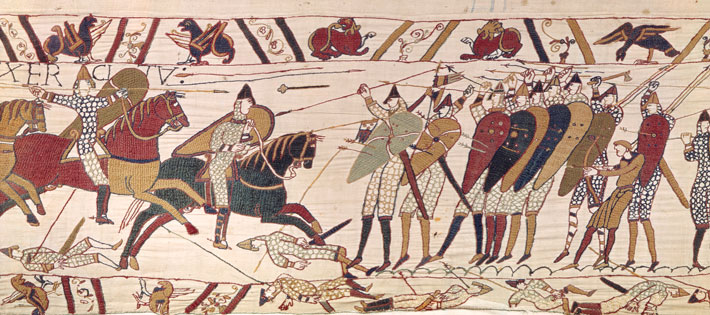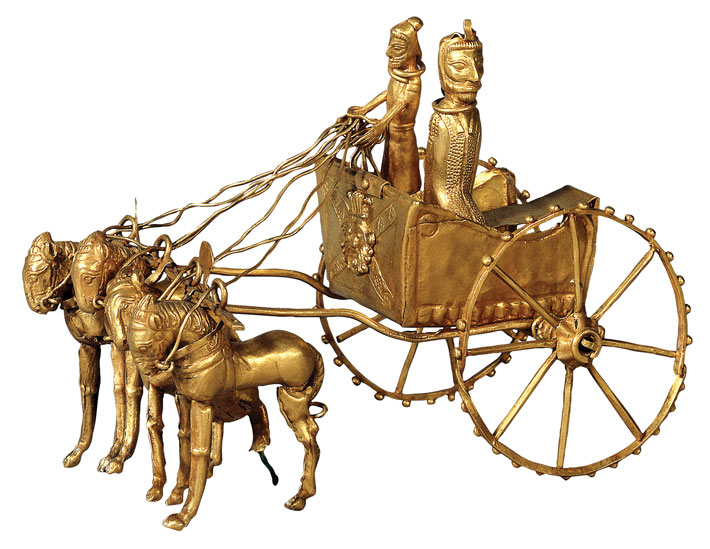Bayeux Tapestry, France, 11th c. A.D.
By the mid-second millennium B.C., the use of horses in warfare had become common throughout the Near East and Egypt. This development was made possible by advances both in the design of chariots, in particular the invention of the spoked wheel, which replaced the solid wooden wheel and reduced a chariot’s weight, and the introduction of all-metal bits, which gave chariot drivers more control over their horses. Though chariot warfare was expensive, and its effectiveness was determined by the durability of the chariots and suitability of the terrain, the vehicles became essential battlefield equipment. According to archaeologist Brian Fagan of the University of California, Santa Barbara, Bronze Age chariots acted largely as mobile archery platforms, with the bulkier four-wheeled ones also being used to carry kings into battle or to allow generals to observe the fighting. Lighter two-wheeled versions, such as those found in Tutankhamun’s tomb, were better suited to carrying a single archer and a driver.
Assyrian, Nineveh, Iraq, 7th c. B.C.
One of the most informative sources for the use of chariot horses in the ancient Near East is a tablet discovered in 1906–1907 in the royal archive at the Hittite site of Hattusa in Anatolia. The “Kikkuli Text,” written in cuneiform script and dating to around 1400 B.C., is named after its author. Kikkuli introduces himself in the first line as a “horse trainer from the land of the Mitanni,” a state in what is now northern Syria and southeastern Turkey. He then describes an approximately 184-day training cycle that begins in the fall, in which he includes instructions for the horses’ feeding, watering, and care, recommending stable rest, massages, and blankets.
Achaemenid, Tajikistan, 5th-4th c. B.C.
For nearly a millennium, warhorses were used almost exclusively to pull chariots, but after about 850 B.C. chariotry began to decline. Horses, however, never lost their usefulness in battle. Within about 150 years, cavalry, which is suitable to almost any terrain, virtually replaced chariotry in the Near East, and, eventually, horse-drawn chariots were employed primarily for racing, in ceremonial parades, and as prestige vehicles. In time this happened not only in this region, but across most of Europe as well. The rise of true cavalry was the determining force behind many of the major events that influenced European history, including Charles Martel’s defeat of the Saracens at the Battle of Poitiers in A.D. 732, the creation of the Holy Roman Empire, and the victory of William the Conqueror at the Battle of Hastings in A.D. 1066. “I think that the most important development in history with respect to animals was the adoption of the horse as a weapon of war,” says Fagan.
Source: http://archaeology.org/issues/180-15...3349-warhorses
peace...
- Home
- Forum
- Chat
- Donate
- What's New?
-
Site Links

-
Avalon Library

-
External Sites

- Solari Report | Catherine Austin Fitts
- The Wall Will Fall | Vanessa Beeley
- Unsafe Space | Keri Smith
- Giza Death Star | Joseph P. Farrell
- The Last American Vagabond
- Caitlin Johnstone
- John Pilger
- Voltaire Network
- Suspicious Observers
- Peak Prosperity | Chris Martenson
- Dark Journalist
- The Black Vault
- Global Research | Michael Chossudovsky
- Corbett Report
- Infowars
- Natural News
- Ice Age Farmer
- Dr. Joseph Mercola
- Childrens Health Defense
- Geoengineering Watch | Dane Wigington
- Truthstream Media
- Unlimited Hangout | Whitney Webb
- Wikileaks index
- Vaccine Impact
- Eva Bartlett (In Gaza blog)
- Scott Ritter
- Redacted (Natalie & Clayton Morris)
- Judging Freedom (Andrew Napolitano)
- Alexander Mercouris
- The Duran
- Simplicius The Thinker








 Reply With Quote
Reply With Quote




Bookmarks